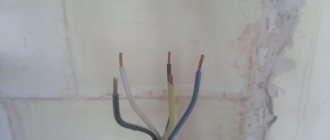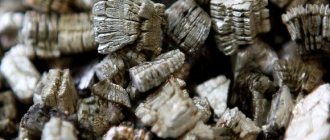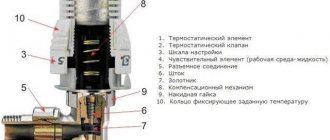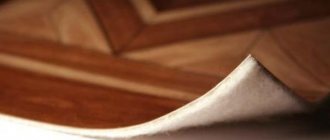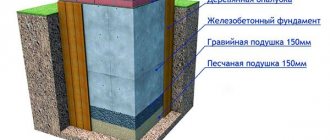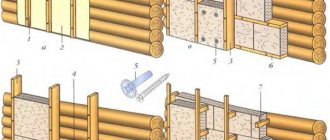Is she needed?
Despite the important and responsible role of the sand cushion, there are often arguments against its use.
The arguments given by opponents of the bedding are as follows:
- No matter how carefully the sand layer is compacted, some settlement will be present in any case. The thicker the cushion, the stronger the settlement, which creates a significant danger for the belt due to its unevenness. Because of this, the thickness of the bedding is limited - it should not be more than three times the width of the tape.
- A layer of sand poured into a trench dug in clay soil will become an accumulator for moisture. The clay will not let it out of the recess, so a high-quality drainage system is necessary.
- The cushion layer has to be taken into account when calculating the depth of a trench or pit, which increases the volume of excavation work and the amount of excavated soil.
Experts with many years of practice are unanimous in the opinion that the main function of the cushion is to level the bottom of the trench (or pit). It is never possible to create a flat and horizontal area by digging alone.
All attempts in this direction result in a significant waste of time without satisfactory results, so bedding allows you to reduce preparation time. With regard to drainage, the situation is usually known in advance, since the hydrogeological situation at the site is analyzed first.
Therefore, the priority task of the pillow is to form an even and horizontal reference line at the desired height level.
The remaining functions of sand backfill can be considered additional, although they are of considerable importance and are performed quite effectively.
There are several design options for a pillow under the tape:
- Sandy. It is a layer of sand of a certain thickness, maximally compacted and horizontal. Distributes the load from the weight of the belt and the building, provides a cutoff from groundwater, and allows you to replace unsuitable soil with more stable and cheaper river sand. It is used primarily for relatively light buildings; such a pillow is not used for heavy and massive buildings.
- Gravel bed. A layer of gravel or crushed stone is used, which can significantly increase the weight of the building. In private construction, this type of pillow is used quite widely, since it allows the backfill layer to be more densely compacted and has a high load-bearing capacity for any home. Sand is also present in the gravel backfill, filling the cavities between larger elements, which makes the layer more dense. Usually there are 60% crushed stone and 40% sand.
- Concrete screed (concrete footing). It is a poured layer of concrete of lower density. The most durable and reliable pillow option, providing horizontal position and high load-bearing capacity. It is used for the heaviest buildings and costs significant amounts.
The choice of the most suitable option is determined by the weight of the future building, soil characteristics and other factors. It is made during the creation of the project, when calculating the foundation.

Why do you need sand bedding?
A sand cushion is formed at the bottom of the pit to avoid freezing of the soil in winter, which can increase wear on the foundation and lead to its premature deterioration or destruction. At the same time, a pillow is not a mandatory element of a new building; its placement under the foundation is recommended in the following situations:
- Construction on heaving soil. The layer of sand replaces the soil removed from the trench, thereby eliminating the possibility of deformation of the base even after several cycles of freezing and thawing of the earth.
- The need to level the construction site. The strip base should be created on a previously prepared area, the bottom of the created trench should not have significant irregularities, and the created embankment allows them to be eliminated.
- Protection of building elements from groundwater. Moisture can have a very adverse effect on the condition of reinforced concrete structures, which is why they need special protection.
- The desire to reduce the building's settlement. Using a pillow, you can reduce the effect of compression forces acting on the base, while it requires minimal financial and time costs for arrangement.
In addition, the pillow can act as a shock absorber if a large building with several floors is planned to be built on the site.
Material requirements
To obtain the most effective design, when choosing its main components, the following basic requirements should be observed:
- The sand for backfilling the foundation must be coarse, dried, and free of foreign impurities.
- Materials must be resistant to temperature changes and precipitation.
- Materials should be well compacted to prevent moisture from passing through them.
- Materials should not change the composition and location of the soil.
- All materials must not contain foreign impurities.
After selecting building materials, you can proceed directly to backfilling.
What to choose, sand or crushed stone?
The choice of backfill material is determined by the weight of the building. The heavier it is, the larger the backfill fraction should be used. The sand layer has a more noticeable settlement, so it is most often used for frame, wooden houses, buildings made of cellular concrete, etc.
Pure coarse-grained river sand is used, which does not have foreign (especially organic) impurities or clay inclusions.
The crushed stone layer has greater elasticity and load-bearing capacity. It is simpler and easier to compact, the pillow is more rigid and reliable. Backfill made of gravel or crushed stone is used in the construction of higher-rise buildings made of heavy and dense materials.
Crushed stone is not used in its pure form; in practice, a sand-gravel mixture is used in a ratio of 60% crushed stone to 40% sand, although in some situations the volume of sand can be reduced or increased.
IMPORTANT! Before backfilling the crushed stone, in any case, an intermediate sand layer about 15-20 cm thick is made. This is done to level the base and create a compensation layer necessary to absorb heaving loads.

Carrying out the bedding procedure in the cold season
The ideal period for work is summer. However, in practice it may turn out that construction needs to be carried out in winter or autumn. At this time, you should take into account the main nuances of the work:
- A pit or trench is dug in advance, preferably in warm weather.
- The structure is made of materials resistant to low temperatures (slag, gravel, crushed stone)
- During work, lumps of snow and ice falling on the surface must be removed.
- When basic building materials freeze, they should be replaced.
- It is recommended to monitor the condition of the soil. Freezing is unacceptable. To prevent it, it is necessary to insulate the surface of the site, both before and after work.
What sand is used in construction
Sand is used in the manufacture of concrete and plaster mortars as an inert filler that does not react chemically with other components. Concrete is one of the main materials in construction, so sand is mined everywhere and on a huge scale. It is conventionally divided into natural and artificial. There may be different deposits in one area, which allows you to choose which sand to buy for the foundation.
Natural sands
They are called large masses of small mineral grains lying at the bottom of rivers, lakes and seas, as well as dune, mountain and gully loose sedimentary rocks. They differ in composition, size and shape of grains:
Sea sand is very fine, with fractions up to 1 mm. It contains various impurities, shells consisting mainly of limestone, so it must be washed before use.
- Sand mined from the bottom of large lakes has similar properties and characteristics. It contains even more mineral and organic impurities, which must be eliminated in order to obtain high-quality concrete.
- River sand, unlike sea and lake sand, is constantly washed by the current, so it is the cleanest, with a very small amount of clay, lime and organic impurities. Its grain size is larger, but the shape, like the previous species, is smooth and round, which is explained by its long-term presence in water.
- Mountain and gully deposits are mined using open-pit mining, which is why they are called quarry deposits. This extraction method is the cheapest, and therefore the material from the quarries has the lowest price. But its quality for use in concrete mixtures leaves much to be desired due to the large number of impurities. They are removed by hydromechanical washing, obtaining washed material, or sifted through a whole system of sieves, removing organic inclusions and stones.

Development of a sand quarrySource onf.ru
If you choose what kind of sand is needed for the foundation - river or quarry, then the quality composition of river sand is better - it is cleaner and does not require additional sifting or washing. But quarry sand grains have an angular rather than a smooth shape, which is preferable for foundation mortars, since they are more durable. Therefore, treated quarry sand is often preferred to river sand, which even after washing is much cheaper.
Artificial sand
Natural deposits of sand are not available everywhere, so in some areas there is a shortage of this material. In addition, its mass production harms the environment. Therefore, it is allowed to use sand of artificial origin in construction, although it can be a stretch to call it such. The fact is that this product is obtained from hard rocks by crushing them. Most often these are screenings obtained during the production of crushed stone.

Screenings from crushing crushed stoneSource kraftbeton.ru
Whether artificial sand is suitable for concrete work depends on the rock that has been crushed, the size of the grains, their strength, abrasion, dust content and other characteristics determined by laboratory tests. As a rule, it is used for the production of decorative solutions and the creation of textured surfaces for facades.
However, high-quality screenings obtained from suitable rocks using centrifugal impact crushers often have all the necessary properties and even improve the strength of concrete due to the rough cuboid-shaped grains that adhere well to the solution. This form is much preferable to that of polished and rounded grains of river sand.
Sand material fractions
Quarry and river varieties are classified according to the size of the elements. Experts distinguish several fractions of quartz rock:
- very thin. Sand grains measuring 0.7 mm are unsuitable for foundation construction. They can be used in arranging children's play areas;
- thin. The grain sizes reach 0.7-1 mm. Loose sand is not suitable as a base component, but is not bad for creating lean concrete;
- very small. The elements are 1.5 mm, but it is not enough to fill the foundation;
- small. Characterized by the presence of fractions of 1.5 – 2 mm. The use of this type of material increases the consumption of the cement mixture;
- average. Grains of 2 to 2.5 mm in diameter are suitable as a component of standard concrete;
- large. Sand grains up to 3 mm in size are ideal for making high-quality concrete mixtures intended for large-scale construction;
- a composition of increased coarseness with grains of sand up to 3.5 mm is needed to cushion the foundation and distribute the mass of the structure over it.
For pouring, only particles with sharp edges are needed, which increase the adhesion of the concrete dough to the surface.
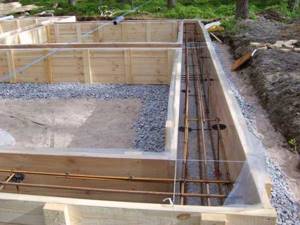
Purpose and thickness of the foundation cushion
The foundation structure is always exposed to the harmful effects of the environment, which can cause it to become less durable. Only the owner who took care of installing the correct cushion under the foundation can avoid weakening the foundation of the house. It is this that makes the surface below the base stable and level.
The pillow is located at the very bottom of the created “pie”
In order for this pillow to perform its task without fail, it must be covered in a thick layer. The thickness of the layer depends on:
- type of foundation;
- dimensions and weight of the structure;
- types of soil on which the building is planned to be erected;
- depth of freezing of the ground;
- proximity of groundwater to the top layer of soil.
Also, the density of the pillow is influenced by the material from which it will be constructed. These raw materials can be sand, crushed stone and gravel mixed with sand.
Sand for the base of the house
Sand cushions are popular because they protect the foundation well from deformation. And the sand bedding blocks access to groundwater to the base of the house.
Most often, sand is poured under the foundation
In order for the foundation cushion to function properly, it must be covered with a thick layer of material. The optimal thickness of each layer of sand is 20 cm.
The sand cushion is located above the ground and below the concrete foundation reinforced with reinforcement
The raw materials used must be medium or coarse-grained. When planning to lay the next layer of such sand, the previous layer of material should be pressed and sprinkled with water.
Video: when and how to make a sand pillow
Crushed stone for the foundation
A crushed stone cushion is chosen when they want to provide the foundation with better protection from destruction. Crushed stone is stronger than sand and therefore is actively used as bedding under the base of a building whose walls are erected from heavy material.
The crushed stone cushion is popular because it is significantly denser than sand
It is customary to pour crushed stone with a size of 2 to 4 cm under the foundation. This diameter of the stones is considered average and allows you to achieve the desired qualities from the pillow: density, evenness and adhesion ability.
The crushed stone cushion, laid on top of the sand, is poured in a layer of 10 cm. But if the construction is heavy, then it is recommended to increase the thickness of the layer of stones to 20 cm. The layer of stones is well compacted, thereby improving the quality of the bedding, which should not sag under the pressure of the foundation.
It is recommended to lay the crushed stone cushion from stones with a fraction of 30–50 mm
Special requirements are imposed not only on the thickness, but also on the width of the pillow. A layer of crushed stone will flawlessly fulfill its task of ensuring the stability of the structure if it is 30 cm wider than the base of the house.
In order for the foundation to be built on a crushed stone bed without problems, the layer of stones should be laid perfectly evenly. Therefore, the zero level is measured in the ground using pegs and when filling the hole with crushed stone, they are guided by it.
Video: example of creating a cushion for a foundation made of crushed stone
A mixture of sand and gravel for the base of the building
They resort to creating a pillow that consists of sand and gravel, wanting to make the pillow durable and at the same time save on the purchase of construction raw materials.
The sand and gravel cushion is laid in layers of different thicknesses. The main thing is that this parameter is at least 5 cm. As a result of filling the hole with several layers of sand and gravel, you should get a cushion 25 cm thick.
The thickness of the sand and gravel cushion is usually 30 cm
Typically, the first layer of sand and gravel cushion is created from limestone fragments, which helps to strengthen the strength of the embankment. The second layer, as a rule, consists of coarse river sand, which is compacted and watered. After this, 15–20 cm of gravel, pressed with a vibrating plate, is poured into the pit.
Progress
Backfilling under the strip foundation is done in the following way:
- Digging a pit or trench
- Removing the fertile soil layer on its surface (depth 30-40 cm)
- Laying of building materials is done in layers. Each layer should have a thickness of no more than 30 cm.
- All layers are well compacted and spilled with water.
- It is necessary to strengthen the slopes of the structure. For this, a layer of soil, stone pavement, or tiles can be used.
- To prevent the walls of the structure from crumbling, it is recommended to strengthen them with supports.
- The structure is installed at a slight angle to the surface of the base (no more than 3 degrees).
- To prevent moisture ingress and subsequent flooding, it is necessary to build a drainage system. The sand bedding under the foundation is strengthened with drainage trays located under a small clone.
Pillow under the ribbon
Today you can find a huge selection of ready-made reinforced concrete foundation pads on sale. Structurally, they are trapezoidal products made of heavy concrete reinforced with a mesh frame. Such blocks optimize the load on the bottom of the foundation and reduce the pressure of the building on the ground.
In addition, the installation of ready-made blocks reduces labor costs during construction. The foundation pads are placed on a sand bedding and connected with cement mortar. Subsequently, foundation blocks are installed on them.
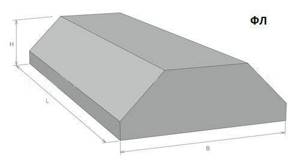
Foundation pad
Experts advise placing a pillow under any tape, regardless of its size and depth. Any sub-base can be laid under the tape: concrete, reinforced concrete, sand, gravel, combined. What specific material can be used depends only on the properties of the soil in the construction site, the ground level and the budgetary capabilities of the future homeowner.
The most common method of constructing a cushion is sand technology, which is most suitable for stable soils with a fairly low groundwater level. Careful layer-by-layer compaction of the sandy base will prevent its subsidence. Sand is poured in layers of 10-20 cm and compacted with a roller or tamper to an approximate density of 1.6 tons per cubic meter. Such density cannot be achieved by trampling, so it is better to rent special equipment. You usually have to roll the sand 5-6 times.
Video - When and how to make a sand cushion under the foundation
In addition to a carefully compacted sand layer, you can use a mixed material. The mixture of sand and gravel should be in the following percentage: 40% sand, 60% gravel with a fraction of 20-40 mm. This type of substrate does not require tamping. This is an excellent option for one-story brick houses and any houses built from lightweight building materials: timber, aerated concrete, etc. In capital construction, it is useless to increase the dimensions of the cushion under the tape. Definitely need to use concrete as a substrate.
What sizes would be suitable:
- Regardless of the material chosen to create it, the thickness of the cushion under the tape should be 3 times the area of the lower part of the foundation wall;
- The width of the tape cushion depends on the stability of the soil. On sand it can be 50 cm-60 cm, on loam or sandy loam - 80 cm;
- if you plan to build a basement, the cushion under it should be the same size as under the foundation.
Since a sand cushion is most often poured under the tape, let’s look at the stages of organizing the work when installing it:
- Digging a trench. The sand cushion should extend to the zero level of the foundation.
- Formwork organization: the boards should also extend to the zero level.
- Laying waterproofing: pouring bitumen or laying roll material. A layer of waterproofing will prevent capillary suction of moisture into the interior.
- Laying and pressing sand in layers.
- Removing formwork.
- Waterproofing device on top.
- Foundation construction.

Installation of prepared formwork with reinforcement
Types of pillows
Backfills and FL reinforced concrete tapes are considered technically correct methods for constructing artificial substrates for foundations. In difficult cases, gaskets made from stone elements are used, for example, when constructing hydraulic structures.
In private and industrial construction, the following types of materials are used:
- coarse rocks (crushed stone, gravel);
- sand;
- monolithic or precast reinforced concrete.
The variety is selected taking into account the number of floors, the budget of the building, the type of soil, the level of ground moisture and the level of freezing. Sand and crushed stone are available in all regions; these materials reduce the loss of heat into the ground and form a strong and reliable foundation.
If the groundwater has a high pressure, there is a danger of the building supports floating up, so the ground under the base is artificially weighted with a concrete layer. They use ready-made FL foundations from factory blocks or pour a monolith.
From sand
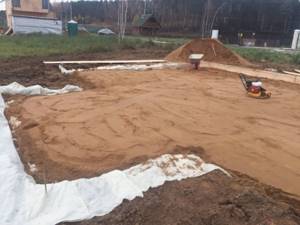
This base is used for houses whose height does not exceed 1 floor. To effectively compact the soil, use material with a grain size of 1–2 mm; river species or washed from quarries work better.
Advantages of sand substrate:
- good thermal insulation from cold;
- possibility of thorough compaction;
- availability and low cost.
If the moisture level rises high, then artificial fabric is installed. Sometimes the heaving layers are removed completely and replaced with sand. The thickness of the layer is chosen individually, most often it is taken by calculation. The sand is laid in layers, each compacted, and the intermediate thickness of the layer is greater with mechanical compaction than with the manual method.
From crushed stone
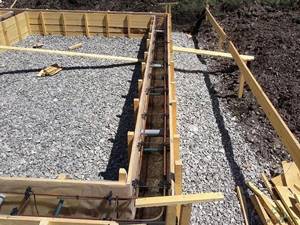
Crushed stone pillow
Crushed stone is obtained by crushing rocks, boulders and gravel; the material is heavy (1.8 - 2.8 t/m3). The substrate for the support of the house is strong and stable after compaction. Such layers can be easily laid independently. Crushed stone backfill requires the installation of a coarse sand layer before installation.
The grain size of 20 – 40 mm is most suitable for a reinforcing layer. A crushed stone foundation cushion is used under low-rise buildings made of stone and brick with reinforced concrete floors and coverings.
The thickness of the layer is chosen so that the top level coincides with the level of the base of the foundation support for the building. The top of the bedding is leveled and leveled using a level. This is done in order to maintain the design height of the foundation and not reduce it. If the top of the crushed stone is below the required level, there will be an overconsumption of concrete onto the monolithic strip.
Concrete
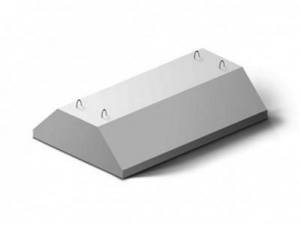
FL block
The concrete base is the most durable, but its cost exceeds previous varieties. The cushion for FBS blocks is made monolithic or prefabricated. Pillow blocks are produced in trapezoidal or rectangular cross-section.
Their parameters:
- height 300 – 500 mm;
- length 800 – 2800 mm.
The blocks are laid on the ground if the soil belongs to the category of sandy bases, or a sand layer 100 - 170 mm thick is made under them. The elements are placed as a continuous strip or placed at intervals into which sand is placed.
In both cases, it is necessary to cover the seams with a subsequent layer of foundation blocks. There are ribbed and hollow versions of prefabricated pillows, but they have not found widespread use. The dimensions of FL blocks are taken according to the design dimensions and according to calculations in the project.
Arranging a concrete cushion
A concrete pad under the foundation of a house, compared to a sand and crushed stone embankment, has an increased load-bearing capacity, but will require significant financial costs.
The recommended thickness of concrete as a cushion for the foundation is 30 cm. The structure made of a mixture of cement and sand should extend beyond the base of the house by 15 cm on each side. So, if the width of the foundation is 70 cm, then liquid concrete is poured into a hole measuring 1 meter.
To create the pillow, lean concrete is used, that is, raw materials of the M100 or M150 grade
The concrete pad is arranged in a special way:
- A hole is dug in the ground.
The area below it is leveled and covered with crushed stone, as a result of which a 10 cm thick layer is formed at the bottom of the pit. The resulting layer of material is pressed with a vibrating plate and covered with plastic film, which will not allow the concrete mixture to leak. Crushed stone is used as the first layer of concrete pad - In a pit, formwork is constructed from boards knocked together, along which reinforcement is placed - a mesh with 20 cm cells, made of metal rods with a diameter of 8 mm.
The height of the auxiliary wooden structure must match the thickness of the concrete pad, which cannot be more than 30 cm. Reinforcing mesh is needed to strengthen the concrete pad - The pit is filled with liquid concrete grade M100 or M150.
Then this construction raw material is pressed with an internal vibrator. Hardened concrete also needs tamping in the same way as crushed stone
Video: stages of creating a concrete pad
So, in places where the ground is relatively stable, a cushion of sand is created. And in areas where the soil freezes strongly and groundwater flows close to the soil surface, a cushion of crushed stone or concrete is installed. Placing certain building materials under the foundation of the house in accordance with the requirements will ensure that the building will stand for many years.
- Author: Ksenia Zubkova
I am a philologist by training and have been writing texts for more than 5 years. Rate this article:
- 5
- 4
- 3
- 2
- 1
(1 vote, average: 5 out of 5)
Share with your friends!
What is the most effective way to compact sand?
#1
Of course, the fastest and most effective way to compact the sand layer is to use a special vibrating plate. The most popular among small-sized ones are the HONKER (imported) or VU-05-45U (domestic) brands. But such a mechanized device may be unreasonably expensive to purchase and is not always available. Since you can compact sand at the dacha under a platform or foundation manually.
#2
For a sand cushion, it is better to use river sand, or coarse and clean ravine sand. But, if you plan to use old reserves from a pile compacted on the site, you will have to first clean such sand from contaminants and remove too fine a fraction from it. There are many instructions on how to wash sand yourself - you should choose the method that is most suitable under the circumstances.
#3
The sand cushion for paths and areas covered with concrete tiles, stone or reinforced concrete should be made at least 150 mm high. Therefore, first, a suitable depression in the soil is planned with a shovel so that the level of the finishing coating is flush with the lawns. But the sand should be compacted in small layers of 5 cm. It is better to pour it through a special metal sieve with a mesh size of 3 - 5 mm. Since sifting sand, even packed in bags, is never superfluous.
#4
Having laid the first layer of sand, it is important to smooth its surface with a long board. The moment of the most labor-intensive and responsible work comes, because if in some area the sand is not compacted sufficiently, it will then sag, and this will damage the integrity of the finishing coating
Start from the corner, pour water on the sand layer and compact it with a timber tamper. When sprinkling the cushion, before creating it, the sand is checked for moisture. If it is dry, then you will need at least 1 bucket of water per 50 kg of sand.
#5
Working with a manual timber rammer is simple, but physically difficult and monotonous
It is important to methodically and evenly distribute the force over the entire backfill area. Having finished with the first layer, repeat in the same way with the remaining two or three
On the same day, until the top layer of sand has dried, you can strengthen the surface of the pillow with sand-cement mortar. The pouring should form a perfectly even cover, since cement and sand must be diluted in a ratio of 1 to 4 and a very liquid solution must be made.
#6
Of course, manual sand compaction takes a lot of effort and time. But after completing this work, you get a very reliable and durable foundation for paths, platforms and even foundations.
A foundation on a sand bed - a whim or a necessity?
Before understanding the device, let’s determine what the sand cushion under the foundation is used for. The main reasons for using this layer are:
Sand allows you to level the bottom of the trench, which is important for subsequent stages of constructing the foundation for the building. Coarse sand, despite the capillary effect, serves as good natural drainage between the foundation and the underlying layers of soil, but only if there are no dense soils with poor water permeability in the environment. A sand cushion under the foundation neutralizes the negative properties of problematic soils, such as clay or soft-plastic loam, plastic sandy loam. The named soils should not be under the foundation, so they are removed and replaced with sand
This manipulation allows you to further avoid, for example, frost heaving of the soil. By organizing a special cushion, the load-bearing capacity of the soil under the sole of the belt increases. Reducing foundation deformations during the spring period of soil thawing. The installation of a sand cushion under a shallow foundation helps to avoid a number of problems that are quite capable of causing deformation, subsidence or cracking of the foundation.
Which sand to choose
The characteristics of sandy soils directly affect their bearing capacity. The main, decisive features can be called the angle of internal friction and adhesion force. The higher these indicators, the better the soil resistance to loads. The larger the faction, the higher the performance. According to the size of the fraction, sand is divided into gravelly, coarse-grained, medium-sized, fine-grained and silty. In the same sequence, sandy soils are located in terms of their density.
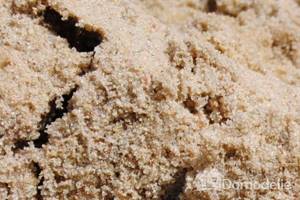
Therefore, it is most preferable to use gravel or coarse sand for a foundation on a sand bed. However, in case of clayey or silty soils on a building site, medium-sized sand (river, quarry) is also suitable.
Trench for strip foundation with high groundwater level
Sand cushion thickness
The thickness is determined based on a calculation that takes into account all the conditions at the construction site, as well as depending on the type of future structure according to the thermal regime (that is, whether it will be heated or not). So, on medium-heaving soil, for the construction of a wooden heated structure, the thickness of the underlying layer must be at least 0.2 meters. And, for example, for a stone unheated structure on a heavily heaving base, the thickness of the sand cushion will be already 1.2 m. However, it is worth keeping in mind that the maximum thickness should not exceed three times the width of the base of the shallow belt.
Is a sand bed always required?
Despite the fact that many resources, as well as periodicals, consider the organization of the underlying foundation as a postulate, in reality its arrangement is not always justified. In some cases it is simply not required, in some others it can even cause the opposite (negative) effect.
The thing is that in dense soils, any sand, no matter how hard it is compacted, will be less dense and, therefore, more permeable. Therefore, all surrounding moisture will accumulate at the base of the foundation. This, firstly, will negatively affect the bearing capacity of the sub-base, and secondly, it will cause moisture in the foundation tape, which will reduce the reliability and service life of the base. Therefore, under the described conditions, such an underlying layer will not only not solve the assigned problems, but, on the contrary, will lead to irreversible consequences.
Working with a walk-behind tractor comes down to a number of simple processes. The motor drives a shaft which...
Properly frozen vegetables retain a large amount of vitamins and microelements. But not all.
The preparatory work has been completed. The formwork is assembled and reinforced with pressure boards and wood.
Since ancient times, this plant has been used in various religious rituals; it was and is part of the composition.
Copyright 2021 Domodelie. All rights reserved.
When using any site materials in full or in part, an active direct link is required
What materials are used?
Having decided at the initial stage that bedding is really necessary, since it allows you to increase the operational life of the foundation, it is necessary to correctly select the materials for it, the sequence of their arrangement, and the thickness of each layer. To do this, it is necessary to take into account the foundation manufacturing technology and the properties of inert materials:
- When sand swells, it turns into a shapeless mass and sharply loses its calculated resistance to prefabricated loads from the weight of the home
- crushed stone retains geometric stability and strength when completely immersed in water (an example is railway embankments)
- You can painlessly lay a roll of sole waterproofing over a compacted sand layer without worrying about the integrity of the carpet
- sharp pebbles of crushed stone do not allow this to be done in principle - the hydroglass insulation is guaranteed to be covered with pinhole punctures, which will negate efforts to waterproof
- if the project includes a monolithic strip foundation, it is necessary to ensure that cement laitance does not leak into the underlying layer of sand and crushed stone, therefore a footing is required
- when choosing a prefabricated tape, the contact surface of the FL slabs with the base must be as smooth as possible; a footing is not needed; it is better to lay the waterproofing on sand
Thus, with high groundwater level, the best option is cube-shaped crushed stone. To save the construction budget in this case, the following scheme can be used:
- 0.4 m of sand with compaction every 10 cm of material
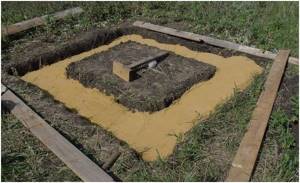
- 0.4 m of crushed stone for a monolithic foundation or 0.2 cm of ASG for a prefabricated tape
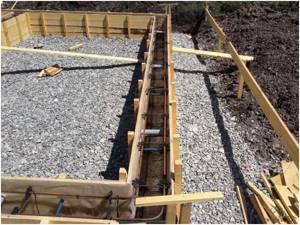
- footing 5 cm (only when concreting the tape)

If the groundwater level is at least 1 m below the base of the foundation, coarse river, washed quarry sand with a minimal clay content can be used to reduce the construction budget.
Sand classification
Sand is a universal natural building material. It is a sedimentary rock consisting of grains of the mineral quartz.
The rock is divided into several modules of rock grain size:
- Large – from 2.5 to 3.5 mm;
- Medium – from 2 to 2.5 mm;
- Small – from 1.5 to 2 mm;
- Very small - from 1.5 to 0.7 mm.
The current legislation in Russia obliges all manufacturers of building materials, including sand minerals, to certify their products. Building materials are divided into three classes:
- Class 1 includes sands with a compressive strength of up to 30 MPa. Used for the manufacture of concrete and reinforced concrete structures;
- Class 2 includes material with a compressive strength of up to 20 MPa. Used for the manufacture of concrete and reinforced concrete products and other structures;
- Special grade 3 sand rock has a compressive strength of up to 40 MPa. It is used for the production of reinforced concrete products with high load-bearing capacity.
Sands, based on their natural origin and methods of extraction, are of several types:
Quarry sand
The mineral is mined in quarries using a mechanized method. This rock contains many inclusions in the form of stones and clay. Without additional processing, it can be used as a foundation filler. The quarry mineral is sifted or washed. Foreign impurities in the form of stones and clay particles are filtered out through a special sieve.
The rock is washed with plenty of water, washing out clay and other inclusions. Alluvial sand rock contains fine particles of about 0.6 mm. It can be used for plastering work.
river sand
I extract river minerals using floating dredges from the river bottom. This rock has better quality characteristics than other types of sand. The high quality and purity of the sand is due to natural purification by the river waters.
Like sea pebbles, the shape of sand grains of river rock is also rounded. Therefore, when using river sand as a foundation cushion, enhanced compaction of the sand layer will be required.
Sea sand
To use sea sand as a building material, it is subjected to double processing. First, in the process of sand extraction, foreign impurities are removed from it, then the rock is subjected to hydromechanical treatment.
The sea mineral is considered one of the highest quality. It is used in all areas of construction.
Sand
A simple and quite effective option for backfilling the foundation. A well-compacted mechanical sand cushion is capable of taking on the same strength and density as the main soil, and at the same time is easily shaped to accommodate all the irregularities in the bottom of the pit.
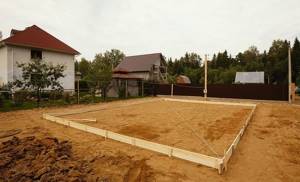
Advantages of sand for backfilling:
- With high-quality compaction, you can achieve a foundation strength equal to the original value for the soil;
- Fills all the unevenness of the pit well and transfers the load evenly;
- Sand retains drainage properties;
- Easily shaped and leveled;
- Does not require the use of heavy construction equipment.
Flaws:
- Weak mechanical strength of transverse point load.
- Sand is washed away by groundwater over time.
Sand for backfilling is ideal when using ready-made reinforced concrete blocks and slabs, allowing the load to be transferred evenly over the entire base.
Sand for backfilling is selected from coarse and medium fractions without clay inclusions. Even with complete compaction, the drainage properties of the base are preserved, and cold heaving has almost no effect on the strength of the base.
The thickness of the bedding can range from 10 to 60-70 cm , depending on the properties of the soil. The depth of soil freezing in many regions of the country exceeds 30 cm, and cold heaving can appear even under a well-insulated foundation during prolonged winter cold spells.
The optimal height for adding sand is considered to be 45-60 cm. Such a layer of sand is difficult to compact at a time, so the material is gradually filled in layers 5 cm thick and gradually compacted and necessarily moistened.
It is quite difficult to determine the required amount of water to moisten the sand. A common mistake is excessive moistening of the sand, as a result of which the entire mass becomes plastic and diverges more to the sides of the tamper than becomes compacted.
The volume of liquid should be determined individually so that the sand is easily crushed in your hands, maintaining the shape of a cake. On the other hand, during mechanical compaction, water should not come out on top of the sand.
The degree of sand compaction is determined quite simply. If there are no traces left on the prepared sand cushion when walking on it, then the base is ready for further work.





